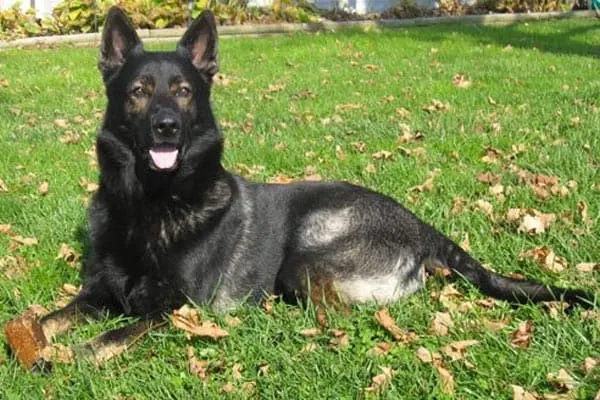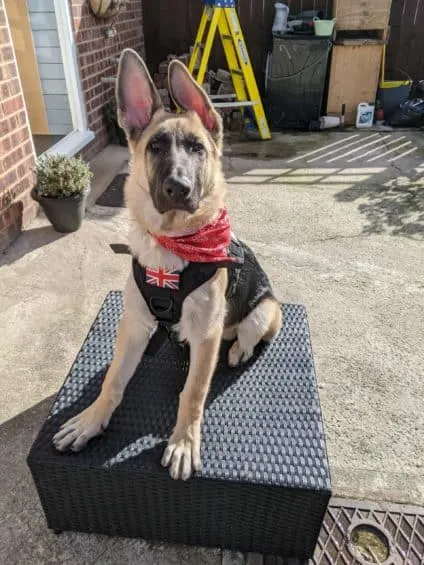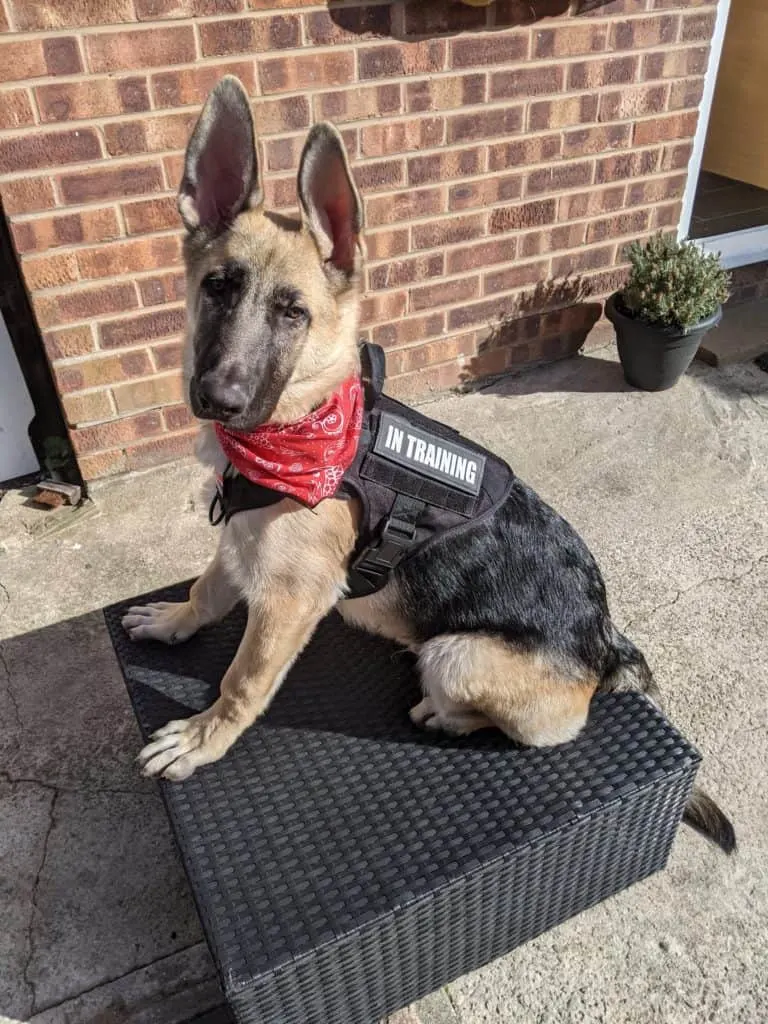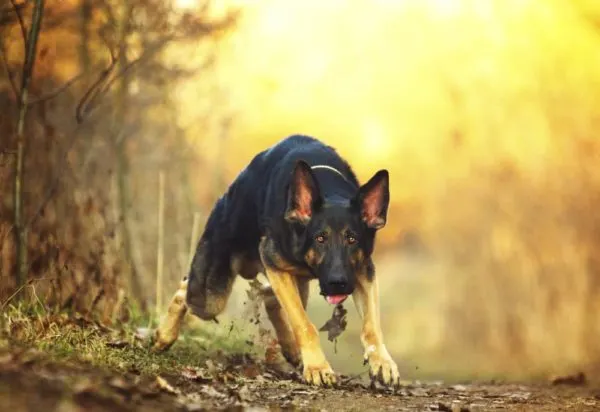DDR German Shepherd: Everything You Need to Know
What is a DDR German Shepherd?
A DDR German Shepherd, also known as an East German Shepherd, is from lines of guard dogs bred in Germany after World War II.
These dogs are known for excelling in police and other protective work.
What Are the Origins and Characteristics of the DDR German Shepherd?
The DDR type of German Shepherd is also known by the name Deutsches Demokratische Republik German Shepherds.
During the Cold War era, the East German Communist Party established a DDR German Shepherd breed breeding program for the dogs used in the military.

At the time, the East German government was trying to keep pace with the changing demands of their country, including dealing with desertion attempts from the military.
Both of the countries saw the advantages that superior dogs would provide.
These dogs were bred with traits like withstanding harsh winter weather and climbing six-foot walls in mind. These traits help the dogs excel in police and military work.
Like all other German Shepherd Dogs, DDR German Shepherds are descended from the same dogs that formed the foundations for the German Shepherd as we know it today.
The dogs that would form the basis of the East German Shepherd type originated from working lines.
Sam Shepherds notes that west german shepherd dogs in former West Germany came from what is now treated as show lines. Many Shepherds used as pets descend from these lines.
When Germany reunified in 1990, the demand for East German Shepherds declined, with some, unfortunately, being put down or abandoned.
Others were sold by breeders intent on preserving the DDR German Shepherd breed type as much as possible, keeping this variety alive.
Many DDR Shepherds have darker coats than other German Shepherds, with sable and black being quite common. The paws are thicker, intended for navigating rougher terrain.
Their heads are also larger and blockier than many others of this breed.
The chest on an East German Shepherd is thicker, with more of a barrel shape. These dogs have more muscle mass than many other Shepherds.
You will also notice that these German Shepherds have straighter backs than you commonly see on dogs from show lines.
This video demonstrates the versatility of these dogs. From military service to family life, these dogs are ready for anything. Seeing these images will give you an idea of what to expect.
What Work Are These Dogs Suited to besides Security?
A DDR German Shepherd’s tracking skills also make these dogs ideal for search and rescue work.
Their ability to traverse all kinds of terrain can help them locate people who are trapped under rubble after all types of disaster situations.
According to The Daily Shep, individual dogs can vary in personality. Some dogs are more protection-minded than others, for example.
German Shepherds have been used as service dogs for decades, and East German Shepherds also have traits that are perfect for work as service dogs.
These dogs are very alert to anything going on near their owners, making reliable guides.
The dogs’ sturdy build helps them guide the blind effortlessly, as well as assist people with mobility issues.
Because these dogs are both tall and strong, they can quickly assist either a child or adult facing problems with mobility.
Which Working Traits Do DDR German Shepherds Have?
DDR German Shepherds share many superior traits that help them excel in many kinds of life. These German Shepherds are loyal, devoted family dogs.
This Shepherd type has a balanced temperament that allows them to be gentle with their family and fiercely protective.
Anyone who shares a home with one of these Shepherds will have the dog’s loyalty. They are wary of anyone or anything perceived as a threat.
Strangers to the dog, from visiting friends or family to service people, require careful introductions to the tracking dogs.
Tracking is one of the functions where East German Shepherds excel.
The East German military used these dogs to track deserters, and the breed type retains many of the traits that helped them to accomplish this type of work.
One of the things that DDR German Shepherds stand out for is having natural drive and intelligence.
Both of these features give the dogs a strong desire to please and an ability to learn new commands very quickly, helpful for any task.
These dogs’ natural drives help them stay focused on whatever task they are involved with, whether it’s protecting livestock, performing search and rescue, or being alert to everything going on in and around the family home.
Some of the dog’s protectiveness could quickly turn into aggression if not keep in check.
When trained properly, there is no reason these dogs cannot be suitable for family life, as well as for performing the work they were bred to perform.
The most important thing that everyone needs to remember about East German Shepherds is that they excel equally as a family, guard dogs, and track dogs.
Their ability to perform all these functions helps make them excellent all-purpose dogs.
How Do DDR German Shepherds Get Along With Children?
With proper socialization at a young age, DDR German Shepherds will get along well with children.
These dogs will not only be active, engaged playmates for your children but will also be their staunchest protectors.
Because German Shepherds, as a whole, were initially bred to protect flocks, it’s not uncommon for them to “herd” children away from perceived danger.
You can expect these dogs to remain alert and watchful whenever children are at play near them.
Playing with children provides these active dogs with a perfect outlet for their energy levels.
Any breed designed to work benefits from having a lot of opportunities to exercise, and German Shepherds are no exception. Eliminating boredom is always helpful.
Even though no dog, including a German Shepherd, should be used as a substitute for supervision, you can trust these dogs to be alert to any possible threats to your children’s safety.
Their family loyalty fully extends to your youngest members.

11-week-old DDR German Shepherd named ‘Midas’
What Do I Need to Keep in Mind When Training a DDR German Shepherd?
One of the most important things to know is that DDR German Shepherds are of a larger size and take longer to mature than some other German Shepherds.
In fact, you should not be too concerned about your dog still acting puppyish until around 18 months.
Any training methods you use with these dogs need to reinforce your leadership and demonstrate a positive attitude.
These dogs have the same high intelligence level common to all Shepherds, and your training efforts need to respect their intelligence.
Most of the principles that apply to other subtypes also apply to East German Shepherds.
Reward-based training works well with all types of German Shepherds. The rewards given take the form of either food treats or praise.
A goal of doing reward-based training is that the dog learns to associate the following commands with good things.
If you do food-based rewards, avoid using human food. Otherwise, your dog might avoid eating their food and also adopt the bad habit of begging.
Use dog food or at least healthy dog treats for better responsiveness to your commands.
Rather than punishing your dog for misbehaving, the best way to deal with disobeying a command is to ignore the dog.
Being denied a treat or praise can be a good motivator for a dog to do as it is told. Punitive methods only confuse and scare dogs.
Never use a harsh tone or raise your voice. Keep your voice steady and calm to increase your dog’s responsiveness.
If you don’t “lose it” with your dog, they will be more likely to pay attention when they give a command or correction.
One thing that you should always do with your DDR German Shepherd is to conduct the initial training, at least, in the same place each time.
Taking this step will help establish a regular routine that your dog will get used to.
Always use the same leash so your dog will get used to walking alongside you and help both of you adjust to its feel.
When you provide a little slack or reduce the slack on the leash, your dog will associate it with following your commands.
Being both patient and assertive will motivate the dog to follow your leadership and guidance. The calmer you are, the more inclined the dog will be to do as you request.
Your dog will come to have a positive association with training when done properly.
What Are Good Activities for a DDR German Shepherd?

18-week-old DDR German Shepherd named ‘Midas’
One of the most important things that owners need to know about DDR German Shepherds is that these are dogs that thrive on a lot of activity.
Like all Shepherds, they require more fulfilling lives than existing ignored in a backyard.
An activity that should be a part of every German Shepherd’s everyday life is a brisk walk once or twice a day. Taking a dog on walks helps provide stimulation.
Another advantage of walking is that it helps to provide better bonding between both of you.
Even though German Shepherds are not bred for retrieving or other hunting-related activities, many learn how to fetch and perform similar activities easily.
Playing Frisbee can also be an exciting activity for a Shepherd.
Having a ladder or ramp that you encourage the dog to climb can help keep their muscles healthy. Your dog’s leg muscles will stay healthy with the activity of this type.
Just make sure that, if leashed, your dog’s leash cannot become tangled.
If your dog has a lot of energy that takes effort to burn off, consider taking your dog out for activities while wearing a backpack or dog weights.
These products will help your dog gradually burn off more of its excess energy.
Consider taking your dog along when you go bike-riding. German Shepherd Dogs are built to keep up with a bike in full motion easily.
One of the best things about this option is that it allows both of you to get exercise.
If you live in or near an area with hiking trails, your dog will enjoy the unique adventures that come with this type of setting.
Hiking is also a relaxing, refreshing way to spend time with your dog when you get outdoors.
Are DDR German Shepherds Likely to Get Hip Dysplasia?
Many owners are surprised to learn that DDR German Shepherds rarely develop hip dysplasia, mainly due to East German breeding practices that mostly eliminated this condition.
Veterinarians have several options for treatment when it occurs.
According to How to Train the Dog, crossbreeding with other German Shepherd Dog lines has sometimes allowed for cases of hip dysplasia to occur.
In addition to crossbreeding among other German Shepherd types, Eastern German Shepherds, who are the product of crossbreeding with other dog breeds, may also be susceptible to hip dysplasia, depending on the different kinds involved.
What Other Health Issues Might a DDR German Shepherd Have?
The East German Shepherd, as a whole, is a type mostly free of common issues that other German Shepherds often end up living with.
The same stringent breeding practices that have eliminated hip dysplasia have eliminated or at least reduced most other problems.
Even though there are fewer instances of hip dysplasia and other joint issues, you will still need to be careful, anyway.
Stiffness or lameness may indicate the beginnings of a bone or joint disease, or possibly an injury.
As some DDR German Shepherds have been crossed with other breeds, it is reasonable to expect these dogs to have inherited some health issues from the other breed.
Keeping up-to-date on veterinary care is an excellent way to catch any possible problems.
If you’ve decided that adding a DDR German Shepherd to your family is right for you, understanding their origins and traits will make welcoming your new dog much more comfortable.
You and your family will enjoy what this dog has to offer.
Our YouTube Video On The DDR German Shepherd
Frequently Asked Questions
What does DDR bloodline mean?
If you are interested in German Shepherds, you might have heard the term ‘DDR Bloodline’ mentioned.
But you might not know what this means. Well, DDR stands for Deutsche Demokratische Republik, and it is a bloodline of German Shepherds that hail from this region of what was once East Germany.
This bloodline of German Shepherds is incredibly rare, as there is only a very small group of true DDR bloodline Shepherds.
This is because this bloodline of Shepherds is limited to a time span of about 40 years of breeding, so not that many DDR Shepherds would have been produced.
DDR bloodline Shepherds are working dogs, and because of this, they are incredibly lean and muscular.
They have heavier bones and a larger head than other bloodlines of German Shepherds, and because of this, it is sometimes easy to distinguish them from other German Shepherds, even though they are rare.
Are DDR German Shepherds rare?
Yes, as we have said, DDR German Shepherds are very rare. At least true DDR German Shepherds are. This is because this bloodline only spanned roughly 40 years of breeding between 1949-1990.
So, the eligible dogs to breed from are very limited.
Due to this, this bloodline of German Shepherds is often viewed as the elite.
Traditionally, German Shepherds are working dogs, and this is what DDR German Shepherds were designed for.
East German shepherds were first bred to be guards of the East / West Germany border and this led to them being able to endure harsh weather conditions around west Germany, which makes them perfect working dogs now.
True DDR German Shepherds are also incredibly athletic, much more than regular German Shepherds or mixed breeds.
It is a combination of all of these different factors and qualities that makes this variation of the breed so popular. Despite the fact that they are very rare.

How much does a DDR German Shepherd cost?
For a regular pedigree German Shepherd, you can expect to spend between $500-1500, but a DDR bloodline will be considerably more expensive.
This is due to the fact that they are incredibly rare and very limited.
So, you should expect to spend anywhere between $1,500-3,000 for a true bloodline DDR German Shepherd.
Generally speaking, you will pay more for a working dog than you would for a pet dog, so this does partly influence the higher cost.
But, you will pay more on top of this due to the fact that DDR bloodline Shepherds are rare.
True DDR bloodline German Shepherds will come with papers to prove this, and this is partly what you are paying for.
So, generally speaking, a true bloodline DDR German Shepherd will cost you anywhere between $1,500 and $3,000.
How long do DDR German Shepherds live?
Although they are from a specific bloodline, DDR German Shepherds have a life expectancy that is very similar to any German Shepherd.
So, you should expect your DDR German Shepherd to live for anywhere between 9-13 years.
Of course, this life expectancy is not a guarantee. Not all dogs will live to reach this age, and some may exceed this life expectancy, this is just an average.
Just because they are a special bloodline doesn’t mean that this bloodline is any different.
However, there are some aspects of this breed line that do give them a better chance of living longer.
But, there is no guarantee as to how long your DDR German Shepherd will live. But, on average, you can expect anywhere between 9 and 13 years of companionship from this type of dog.
How much do DDR German Shepherds weigh?
Although they have large heads and more muscular bodies, DDR German Shepherds weigh a similar amount to regular German Shepherds.
Again, this is just an average, but you can expect your male DDR German Shepherd to weigh anywhere between 30-40kg.
Female DDR German Shepherds will be smaller, and because of this, they will usually weigh between 22-32kg.
As this is just an average, there is no guarantee that your DDR German Shepherd is going to fall into this weight category. You might have a female DDR German Shepherd who falls into the male weight category.
Likewise, you may have a male DDR German Shepherd that is smaller than average, falling into the female weight category.
So, there is no guarantee of what weight your DDR German Shepherds will be. However, you should expect them to weigh anywhere between 22 and 40kg depending on their gender and muscular build.































